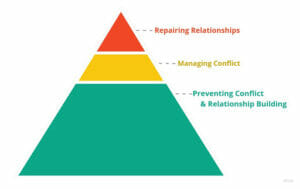Language: Español
5 Ways you’re already using restorative practices and how to become even more restorative when using sociocracy
“Don’t tell anyone else we’ve trained, but this is by far the most restorative school I’ve ever seen.”
I was shocked to hear that from the restorative practices trainer who visited our school. At the time, I barely understood what a “restorative community” even meant. I thought we were just practicing sociocracy. It turns out that simply practicing sociocracy helped prepare for conflict through intentional relationship building.
What does a restorative school look like? Posters about conflict resolution and community agreements are posted on the walls. Sticky notes with feedback and ideas for how to make things better are on prominent display- we are actually listening to students and parents and allowing them to share in governance. Circles are held to share feelings and resolve conflict through restorative practices. Seeing our check-in and check-out rounds, the trainer was impressed with the trust and emotional intelligence displayed by the group.
Since then I’ve looked more deeply into restorative practices and restorative justice, and the more I look, the more convinced I am that restorative practices and sociocracy are mutually supportive structures that serve to build stronger, more compassionate communities.
Introduction to restorative practices
Perhaps you have heard the buzzwords “restorative justice” or “restorative practices,” and have wondered if you should look into them for your organization, but just haven’t gotten around to it just yet. The good news is, if you are practicing sociocracy, you are probably already more than halfway there! Restorative practices, which emphasize conflict preparedness and relationship building, have significant overlap with practices used in sociocracy.
In a sociocratic organization, using restorative practices more intentionally may improve feelings of goodwill, remove the need for punitive conflict resolution, and reduce members of the organization leaving due to unresolvable conflict. Using restorative practices in schools is correlated with reduced suspensions and student conferences. Teachers surveyed from schools that use restorative practices have noticed an improvement in school culture.
How do sociocracy and restorative practices overlap?
Sociocracy is a set of tools and principles that ensure shared power.
Restorative practices are a social science that studies how to build social capital and achieve social discipline through participatory learning and decision making.
As you can see, there is a lot of overlap just within the definitions above with sharing power and participatory decision making.
The restorative practices pyramid
 If you imagine restorative practices as a pyramid, 85% of the work is building relationships, establishing routines and creating community. Using sociocracy can look like asking for feedback, making community agreements, having rounds on community topics, practicing circles, and relationship building. The focus is on preventing conflict escalation. If you are practicing sociocracy, you may have 85% of restorative practices under your belt!
If you imagine restorative practices as a pyramid, 85% of the work is building relationships, establishing routines and creating community. Using sociocracy can look like asking for feedback, making community agreements, having rounds on community topics, practicing circles, and relationship building. The focus is on preventing conflict escalation. If you are practicing sociocracy, you may have 85% of restorative practices under your belt!
In our school, relationship building looks like playing games together, getting to know each other, talking about feelings in rounds, and sharing gratitude by taking time to notice and articulate what is working well.
10% of the pyramid is responding to difficulties in relationships, such as conflicts. It could be by using Non-Violent Communication or one-to-one mediation practices. At our school, we use conversational templates and mediation request forms to practice conflict resolution.
5% of the pyramid is restorative actions taken to repair harm in relationships. This could mean a restorative circle to help mend interpersonal harm, or a larger circle to repair the harm done to the community at large.
5 ways sociocratic governance is fundamentally restorative
The “base” of the restorative pyramid
There is a huge overlap in sociocracy and restorative practices. I will walk you through 5 examples of how this works in practice.
1. Speaking in rounds: connection and group wisdom
 Speaking in rounds creates equivalence, and ensures all voices are heard. It also normalizes speaking in circles, which prepared everyone for restorative circles if they are needed after a conflict. To make an organization more restorative, you can use round prompts to more deeply check in about feelings or complicated topics. As a restorative practices trainer told me, “The magic is in watching wisdom arise from the circle.”
Speaking in rounds creates equivalence, and ensures all voices are heard. It also normalizes speaking in circles, which prepared everyone for restorative circles if they are needed after a conflict. To make an organization more restorative, you can use round prompts to more deeply check in about feelings or complicated topics. As a restorative practices trainer told me, “The magic is in watching wisdom arise from the circle.”
 2. Check-in round/Check-out round
2. Check-in round/Check-out round
Check-in and check-out rounds are restorative in the hearing of how everyone is feeling and doing, it helps to create stronger relationships. It is also a chance to practice noticing what you feel and to be concise in communicating that to others. Check-in and check-out rounds often lead to a feeling of trust and deep connection. Relationship-building circles are a restorative practice.
 3. Consent decision making
3. Consent decision making
As it says in the definition above, participatory learning and decision-making are foundational to restorative practices. Consent decision-making in circle structures is, by definition, restorative since they incorporate participatory decision-making.
 4. Feedback loops
4. Feedback loops
The more community participation seeking feedback on agreements and proposals, the more restorative your community will be. Asking the community what impact they foresee for a proposal that affects them to prevent unintended consequences. If unintended consequences become clear, the regular feedback loops of checking in on proposals can help repair harm done.
 5. Consider the whole person
5. Consider the whole person
Inherent in both sociocracy and restorative practices is the mindset of considering the whole person as a social, emotional, and reasoning being. Sociocracy harnesses the best thinking to produce effective decisions in governance, while also treating people respectfully and proceeding mindfully.
Room for improvement: How can we become even more restorative?
OK, now you know that you are going on the path of restorative. But, of course, there is always room for improvement. How can you take the next steps? By focusing on community agreements, relationship building, and explicit and concrete conflict processes, you can build a more resilient and restorative organization. Use sociocratic processes to come to consent about agreements and conflict processes.
1. Core Agreements: Building The Foundation
- What are your community agreements? Do you have a code of conduct?
- What are the shared values of the organization?
- Are these agreements and values visible?
- Post agreements and shared values on the wall.
- Write them on meeting agendas.
- ring questions to governance rounds and use the proposal-making process if agreements are not currently clear.
- Ask for feedback on proposals from the whole community, and display feedback widely. You can use posters and sticky notes and leave them out in common spaces for people to give feedback on.
2. Relationship Building Tools: Strengthening Community
- What do you do in your organization currently to help build relationships?
- Are there ways to integrate connection into your daily routines?
- Making time for ice-breakers, team-building exercises, or just time and inviting space to hang out and chit-chat can all lead to more effective work towards a common goal, as well as preventing conflict.
- Sharing gratitude is a great way to both, center a group and focus on the positive aspects of your community.
- Ask community members frequently: What is going well? This can be incorporated into every meeting check-out round.
- Try the 5:1 ratio of positive interactions to critical or negative interactions.
3. When Conflict Happens, What Next? (Top 15% of the Pyramid)
- What are the conflict processes in your organization?
- Are they clear, and consented to?
- What happens when agreements are broken? What happens when harm is done to an individual or the community?
- Consent to conflict processes before conflict builds up!
- Encourage and model engaging in conflict resolution practices while the conflict is still small before it builds up to something major.
I hope this helps you understand how sociocracy is a fundamentally restorative tool and provides clear next steps for building an even more restorative community.
Resources:


Leave a Reply
You must be logged in to post a comment.